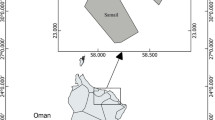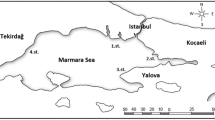Abstract
This study focuses on the extent of zinc (Zn), copper (Cu), cadmium (Cd), cobalt (Co), manganese (Mn), lead (Pb), mercury (Hg), and arsenic (As) bioaccumulation in edible muscles of Caspian kutum (Rutilus frisii kutum), in both male and female sexes at Noor and Babolsar coastal regions from the southern basin of Caspian Sea. These values were compared with the WHO and the UNFAO safety standards regarding the amount of the abovementioned heavy metals in fish tissues (mg/kg ww). Results showed that the accumulation of these elements (except for Zn) was not significantly different between sexes of male and female in Babolsar coastal regions (P > 0.05). In the other hand, accumulation of Hg and As at edible muscles of Caspian kutum has significant difference between two sexes of male and female in Noor coastal regions (P < 0.05), the female had higher concentration than the male. Furthermore, it was not significantly correlated with sex and rivers in length and weight of fish (R 2 < 0.50; P > 0.05). Based on the results, the concentration of heavy metals in the studied fish tissues proved to be significantly lower than international standards (P < 0.05), so its consumption is not a threat to the health of consumers.


Similar content being viewed by others
References
Adeosun F, Akinyemi A, Idowu A, Taiwo I, Omoike A, Ayorinde B (2015) The effects of heavy metals concentration on some commercial fish in Ogun River, Opeji, Ogun State, Nigeria. Afr J Environ Sci Technol 9:365–370
Agusa T, Kunito T, Tanabe S, Pourkazemi M, Aubrey DG (2004) Concentrations of trace elements in muscle of sturgeons in the Caspian Sea. Mar Pollut Bull 49:789–800
Akoto O, Bismark Eshun F, Darko G, Adei E (2014) Concentrations and health risk assessments of heavy metals in fish from the Fosu Lagoon. Int J Environ Res 8:403–410
Anan Y, Kunito T, Tanabe S, Mitrofanov I, Aubrey DG (2005) Trace element accumulation in fishes collected from coastal waters of the Caspian Sea. Mar Pollut Bull 51:882–888
Carvalho M, Santiago S, Nunes ML (2005) Assessment of the essential element and heavy metal content of edible fish muscle. Anal Bioanal Chem 382:426–432
Chary NS, Kamala C, Raj DSS (2008) Assessing risk of heavy metals from consuming food grown on sewage irrigated soils and food chain transfer. Ecotoxicol Environ Saf 69:513–524
Cheng S (2003) Heavy metal pollution in China: origin, pattern and control. Environ Sci Pollut Res 10:192–198
Choudhury RP, Reddy A, Garg A (2007) Availability of essential elements in nutrient supplements used as antidiabetic herbal formulations. Biol Trace Elem Res 120:148–162
Cui L, Ge J, Zhu Y, Yang Y, Wang J (2015) Concentrations, bioaccumulation, and human health risk assessment of organochlorine pesticides and heavy metals in edible fish from Wuhan, China Environmental Science and Pollution Research:1–14
Dadar M, Peyghan R, Memari HR (2014) Evaluation of the bioaccumulation of heavy metals in white shrimp (Litopenaeus vannamei) along the Persian Gulf coast. Bull Environ Contam Toxicol 93:339–343
Dural M, Göksu MZL, Ozak AA (2007) Investigation of heavy metal levels in economically important fish species captured from the Tuzla lagoon. Food Chem 102:415–421
Eslami S, Moghaddam AH, Jafari N, Nabavi SF, Nabavi SM, Ebrahimzadeh MA (2011) Trace element level in different tissues of Rutilus frisii kutum collected from Tajan River, Iran. Biol Trace Elem Res 143:965–973
Esmaeili HR et al (2015) An updated checklist of fishes of the Caspian Sea basin of Iran with a note on their zoogeography. Iran J Ichthyology 1:152–184
Hoseini H, Tahami MS (2012) Study of heavy metals (Pb and Cd) concentration in liver and muscle tissues of Rutilus frisii Kutum, Kamenskii, 1901 in Mazandaran province health 8:9
Huang W-B (2003) Heavy metal concentrations in the common benthic fishes caught from the coastal waters of Eastern Taiwan Journal of food and drug analysis 11
MacFarlane G, Burchett M (2000) Cellular distribution of copper, lead and zinc in the grey mangrove, Avicennia marina (Forsk.) Vierh. Aquatic Botany 68:45–59
Miniadis-Meimaroglou S et al (2007) Proximate composition, fatty acids, cholesterol, minerals in frozen red porgy. Chem Phys Lipids 146:104–110
Monsefrad F, Imanpour Namin J, Heidary S (2012) Concentration of heavy and toxic metals Cu, Zn, Cd, Pb and Hg in liver and muscles of Rutilus frisii kutum during spawning season with respect to growth parameters. Iran J Fish Sci 11:825–839
Nussey G, Van Vuren J, Du Preez H (2000) Bioaccumulation of chromium, manganese, nickel and lead in the tissues of the moggel, Labeo umbratus (Cyprinidae), from Witbank Dam, Mpumalanga WATER SA-PRETORIA- 26:269–284
Pourang N, Tanabe S, Rezvani S, Dennis J (2005) Trace elements accumulation in edible tissues of five sturgeon species from the Caspian Sea. Environ Monit Assess 100:89–108
Raeisi S, Sharifi Rad J, Sharifi Rad M, Zakariaei H (2014) Analysis of heavy metals content in water, sediments and fish from the Gorgan bay, southeastern Caspian sea, Iran. Int J Advanc Biol Biomed Res 2:2162–2172
Ruelas-Inzunza J, Meza-López G, Páez-Osuna F (2008) Mercury in fish that are of dietary importance from the coasts of Sinaloa (SE Gulf of California). J Food Compos Anal 21:211–218
Saghali M, Hoseini SM, Hosseini SA, Baqraf R (2014) Determination of heavy metal (Zn, Pb, Cd and Cr) concentration in benthic fauna tissues collected from the southeast Caspian Sea, Iran. Bull Environ Contam Toxicol 92:57–60
Sivaperumal P, Sankar T, Nair PV (2007) Heavy metal concentrations in fish, shellfish and fish products from internal markets of India vis-a-vis international standards. Food Chem 102:612–620
Somers E (1974) The toxic potential of trace metals in foods. A review. J Food Sci 39:215–217
Staniskiene B, Matusevicius P, Budreckiene R, Skibniewska KA (2006) Distribution of heavy metals in tissues of freshwater fish in Lithuania. Pol J Environ Stud 15:585–591
Turkmen M, Turkmen A, TEPE Y (2008) Metal contaminations in five fish species from Black, Marmara, Aegean and Mediterranean seas, Turkey. J Chil Chem Soc 53:1424–1428
Türkmen M, Türkmen A, Tepe Y, Ateş A, Gökkuş K (2008) Determination of metal contaminations in sea foods from Marmara, Aegean and Mediterranean seas: twelve fish species. Food Chem 108:794–800
Watanabe I et al (2002) Accumulation of heavy metals in Caspian seals (Phoca caspica). Arch Environ Contam Toxicol 43:109–120
Xue Z-J, Liu S-Q, Liu Y-L, Yan Y-L (2012) Health risk assessment of heavy metals for edible parts of vegetables grown in sewage-irrigated soils in suburbs of Baoding City, China. Environ Monit Assess 184:3503–3513
Yousefian M, Mosavi H (2008) Spawning of south Caspian kutum (Rutilus frisii kutum) in most migratory river of South Caspian Sea Asian. J Anim Vet Adv 3:437–442
Zhou J, Salvador S, Liu Y, Sequeira M (2001) Heavy metals in the tissues of common dolphins (Delphinus delphis) stranded on the Portuguese coast. Sci Total Environ 273:61–76
Acknowledgments
This study was supported by the Caspian Sea Ecology Research Center and Shahid Chamran University. The authors wish to thank Dr. Maria Graças A. Korn for his kind assistance.
Author information
Authors and Affiliations
Corresponding author
Additional information
Responsible editor: Philippe Garrigues
Rights and permissions
About this article
Cite this article
Dadar, M., Adel, M., Saravi, H.N. et al. A comparative study of trace metals in male and female Caspian kutum (Rutilus frisii kutum) from the southern basin of Caspian Sea. Environ Sci Pollut Res 23, 24540–24546 (2016). https://doi.org/10.1007/s11356-016-6871-2
Received:
Accepted:
Published:
Issue Date:
DOI: https://doi.org/10.1007/s11356-016-6871-2




